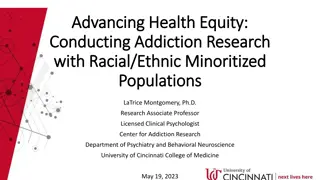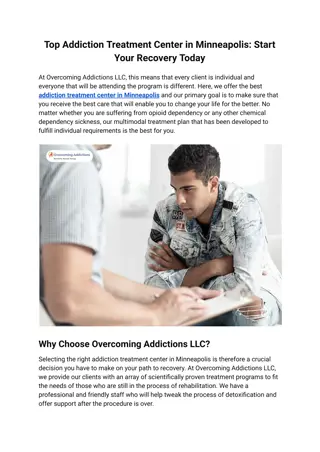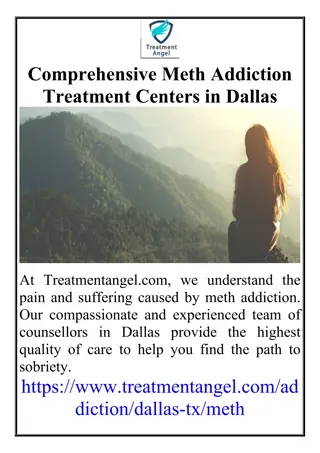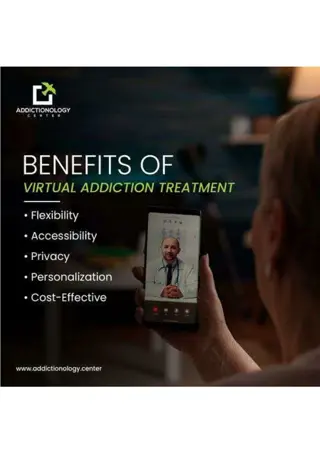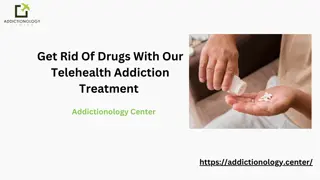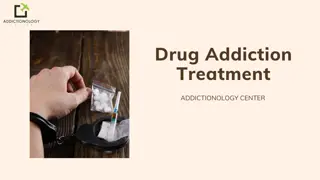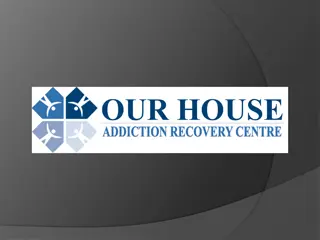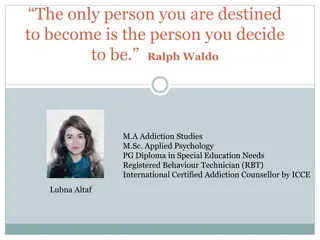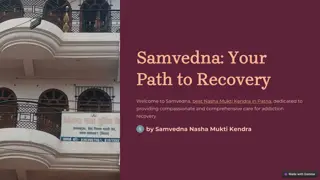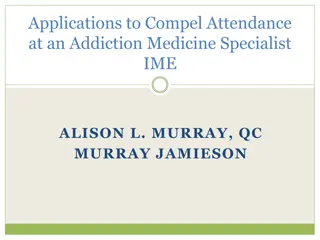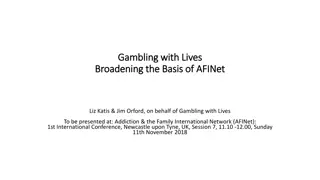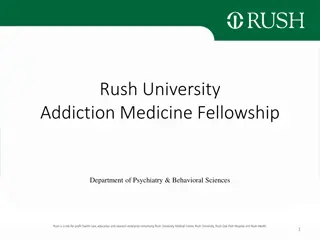Understanding Addiction: A Comprehensive Introduction
Addiction is defined as a treatable, chronic medical disease involving complex interactions among brain circuits, genetics, environment, and life experiences. It is not caused by another mental illness or trauma, a moral or ethical problem, a personality disorder, or lack of social connection. Like other chronic diseases, addiction often involves cycles of recurrence and remission. Risk factors include biological and psychological factors as well as environmental influences. The brain's old and new regions play essential roles in addiction behavior.
Download Presentation

Please find below an Image/Link to download the presentation.
The content on the website is provided AS IS for your information and personal use only. It may not be sold, licensed, or shared on other websites without obtaining consent from the author. Download presentation by click this link. If you encounter any issues during the download, it is possible that the publisher has removed the file from their server.
E N D
Presentation Transcript
Addiction IN T R O TO AD D ICT I O N , TREATMENT & STIGMA Presented by: Sharon A. Hesseltine, Opioid Response Network Maggie Schroeder, KY DBHDID 1
ADDICTION IS NOT: Caused by another mental illness or trauma A moral or ethical problem A personality disorder A choice Caused by lack of social connection or isolation
Understanding Addiction Defining Addiction The American Society of Addiction Medicine (ASAM) defines Addiction as: A treatable, chronic medical disease involving complex interactions among brain circuits, genetics, the environment, and an individual s life experiences. People with addiction use substances or engage in behaviors that become compulsive and often continue despite harmful consequences. Key Takeaways: Addiction is a chronic brain disease, with the possibility of remission and recovery Prevention efforts and treatment approaches for addiction are generally as successful as those for other chronic diseases. 3 ~American Society of Addiction Medicine, 2019
Like Other Chronic Diseases, Addiction Often Involves Cycles Of Recurrence And Remission
Risk Factors for Addiction Biological factors Genetics/epigenetics Psychological factors People with mental health concerns are at a greater risk for drug misuse and addiction Examples: Stress, high impulsivity, depression, anxiety, eating disorders (Center on Addiction, 2017) Environmental Influences Exposure to physical, social, or emotional abuse or trauma (Center on Addiction, 2017) Home and family environment parents/family who misuse drugs or criminal record, decreased parental supervision Peers and school peers who misuse drugs, difficulties in school performance, and having poor social skills Community poverty, lack of resources 5 (NIDA, 2018)
Old Brain Three Main Functions: Regulate physiological functions Experience basic emotions (anger, fear, hunger, thirst, lust, pain and pleasure) Imprint survival memories Overrides new brain in times of stress Can be thought of as the go or reactive part of the brain
The New Brain: Prefrontal Cortex Coping Functions Attention span Organization Learning from experience Empathy Problem Solving Executive Functions (not fully developed until age 25) Judgment Impulse control Self-monitoring
DOPAMINE Neurotransmitter Signals reward in our brains Also increased by stimuli that predict a reward Brain itself will drive the repeating of what it perceives as life-sustaining activity Over time when the brain is regularly flooded with dopamine (and other neurotransmitters) it will reduce the natural production
BRAIN CHANGES INHERENT TO ADDICTION Less dopamine produced Fewer dopamine receptors Ability to experience normal reward feel joy reduced significantly Using no longer pleasurable, but about trying to get dopamine function back to a normal level Brain is driven to seek out and use substances compulsively Ability to make sound decisions and control impulses is compromised NIDA Drugs, Brains and Behavior: The Science of Addiction
Stigma of Addiction An article in the International Journal of Drug Policy provides a break down three types of stigma: 1. Public when the general population endorses stereotypes and decides to discriminate against people labeled with a behavioral health disorder 2. Self occurs when people with behavioral health challenges internalize corresponding stereotypes and prejudices. 3. Label Avoidance occurs when public stigma impacts care seeking of people with behavioral health disorders. The next slide shows how the authors break down stereotypes, prejudices, and discrimination that can occur as a result of these types of stigma 10 (Corrigan & Nieweglowski, 2018)
Stigma of Addiction Public Stigma People who use opioids are: dangerous, immoral, to blame for their disorder , criminal. Self Stigma Because I use opioids, I am dangerous, immoral, and ashamed. Leads to lower self-esteem and self-efficacy Label Avoidance I perceive the public disrespects and discriminates against people with substance use disorders. Stereotypes & Prejudices Discrimination Employers not hire, landlords do not them, primary care providers lower standard care should Someone like me is not worthy or unable to work, live independently, or have good health. I do not want this. I will Avoid the label by not seeking out treatment rent to offer a of (Corrigan & Nieweglowski, 2018) 11
Stigma of Addiction Language Matters! Words to Avoid Words to Use Addict Drug Problem/Habit Person with substance use disorder Substance use disorder Drug abuse Drug misuse Harmful use Drug Abuser Person with substance use disorder Clean Abstinent not actively using Dirty Actively using A clean drug screen T esting negative for substance use A dirty drug screen T esting positive for substance use Former/reformed addict Person in recovery Person in long-term recovery Opioid replacement Methadone maintenance Medications for addiction treatment The Office of National Drug Control Policy s Stigma Reducing Language 12
Treatment The National Institute on Drug Addiction (NIDA) outlines 13 principles for effective treatment of drug addiction in their 2018 publication Principles of Drug Addiction Treatment: A Research-Based Guide (Third Edition) (NIDA,2018) 13
Treatment The National Institute of Drug Addiction (NIDA) emphasizes that treatment of addiction is a long-term process that involves multiple interventions and regular monitoring. NIDA outlines an approach to comprehensive treatment in the diagram to the right (NIDA, 2018) 14
Treatment The American Society of Addiction Medicine outlines treatment for substance use disorders as being on a continuum and organized into levels of care. Higher severity in substance use will require a more intense level of care. As a patient moves through treatment they step down to lower levels of care. Levels of care inform both the setting for care and the number of hours of clinical behavioral health services. 15 (Addiction Policy Forum, n.d.)
Treatment Treatment options can be categorized into three general categories: 1.Behavioral 2.Pharmacologic 3.Harm Reduction The combination of behavioral therapies and pharmacologic intervention tend to be more effective. Treatment plans should be tailored to the unique needs of the individual patient 16 (Addiction Policy Forum, n.d.)
Behavioral Health Treatment Behavioral treatments focus on changing attitudes and actions related to substance use. These interventions help patient with the following: Being able to engage and remain in treatment Modify their existing substance use behaviors Prepare them to handle cravings and stressful situations without using substances Examples include: Cognitive Behavioral Therapy (CBT), Contingency Management Interventions, 12-Step Facilitation Therapy , Family Behavior Therapy . (Addiction Policy Forum, n.d.) 17
Pharmacologic Intervention Medications that Treat Addiction & Support Recovery (previously referred to as MAT, now MOUD) MOUD is the use of medications in combination with behavioral counseling to treat substance use disorders. FDAApproved medication for treatment of opioid use disorder , alcohol use disorder , and tobacco use disorder are currently available. Opioid Use Disorder MAT is considered the gold standard of treatment for OUD. This intervention helps to stabilize brain chemistry and relieve cravings so the patient can engage in behavioral aspects of treatment such as counseling, peer support programs, and family therapy. 18 (Addiction Policy Forum, n.d.)
Common Medication Options Include Methadone - reduces opioid craving and withdrawal and blunts or blocks the effects of opioids. Methadone must be taken under supervision of a physician. By law, methadone is only dispensed through SAMHSA-certified opioid treatment programs Buprenorphine - a partial opioid agonist that produces effects such as euphoria or respiratory depression at low to moderate doses. Buprenorphine is only dispensed through SAMHSA-certified opioid treatment programs by providers that hold a Buprenorphine waiver to oversee this treatment (see next slide for more details). Naltrexone blocks the euphoric and sedative effects of drugs such as heroin, morphine, and codeine. Naltrexone binds and blocks opioid receptors, which reduces cravings. Naltrexone can be prescribed by any provider who is licensed to prescribe medications 19 (SAMHSA, 2020)
Harm Reduction & Overdose Prevention Strategies- Needle Exchange/Syringe Service Programs The opioid crisis is facilitating a dramatic increase in infectious disease associated with injection drug use Syringe service programs are comprehensive community-based prevention and intervention programs that provide services such as: vaccination, testing, linkage to infectious disease care and substance use treatment, and access to and disposal of syringes and injection equipment. CDC data provides the following support for SSPs estimates a 50% reduction in HIV and Hep C incidence is associated with Syringe Service Programs (SSPs) SSPs offer referrals to MAT , new users of SSPs are 5x more likely to enter drug treatment and 3x more likely to stop using drugs than those who don t use these programs 20 (CDC, 2019)
FOUR DIMENSIONS OF RECOVERY HOME Permanent Housing HEALTH Recovery Health Wellness COMMUNITY Peer/Family/ Recovery Network Supports Individuals and Families PURPOSE Employment/ Education
Addiction in the United States SAMHSA s Behavioral Health Barometer published in 2019presents indicators as measured through the 2017National Survey on DrugUse and Health and the National Survey of Substance Abuse Treatment Services. State reports provide a snapshot of substance use and mental health in the United States. (SAMHSA, 2019) 23
Addiction in the United States Reports containing national maps that provide substance abuse and mental health estimates across all states and the District of Columbia, including: the prevalence of substance use and abuse treatment mental health indicators (SAMHSA, 2019) 24




